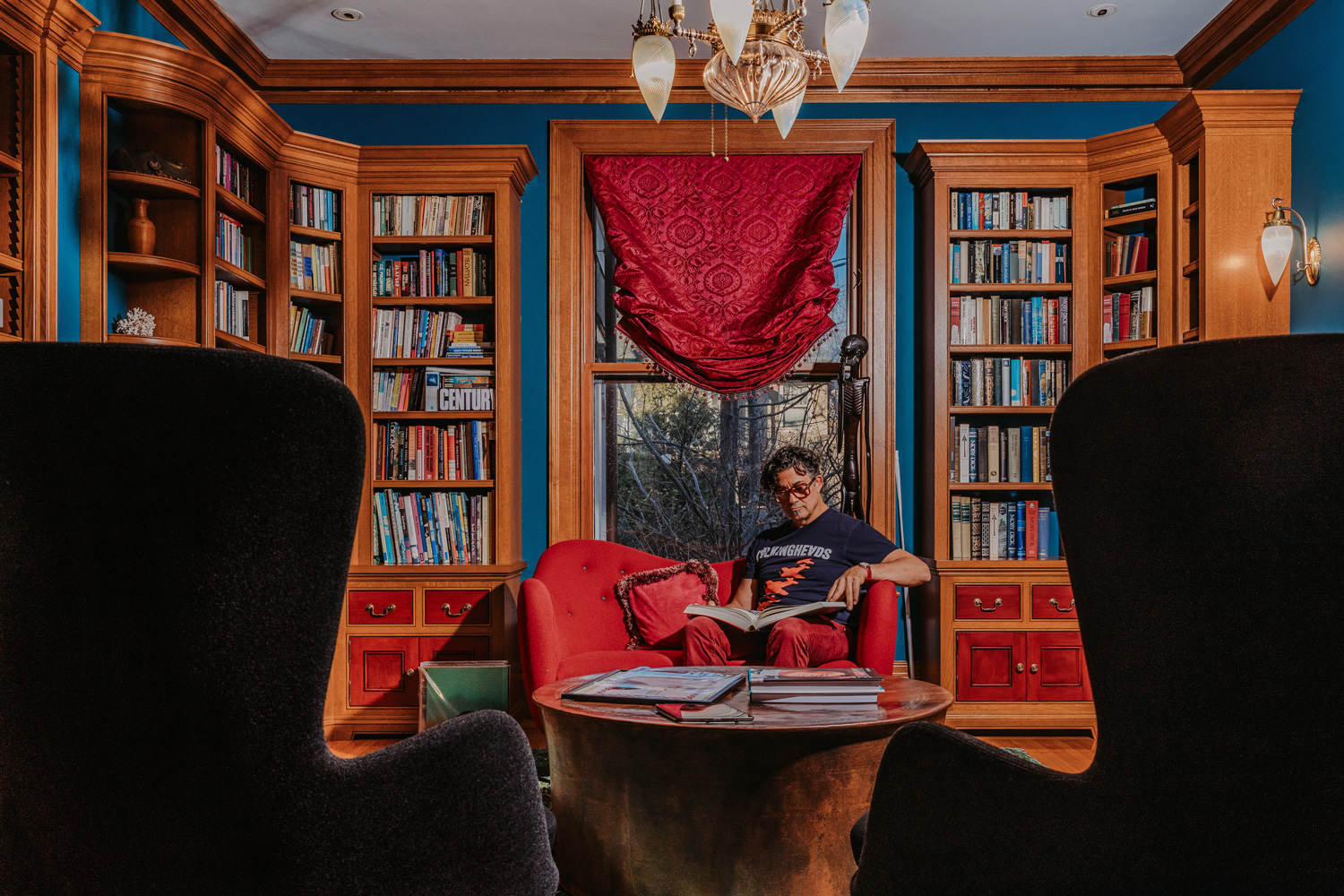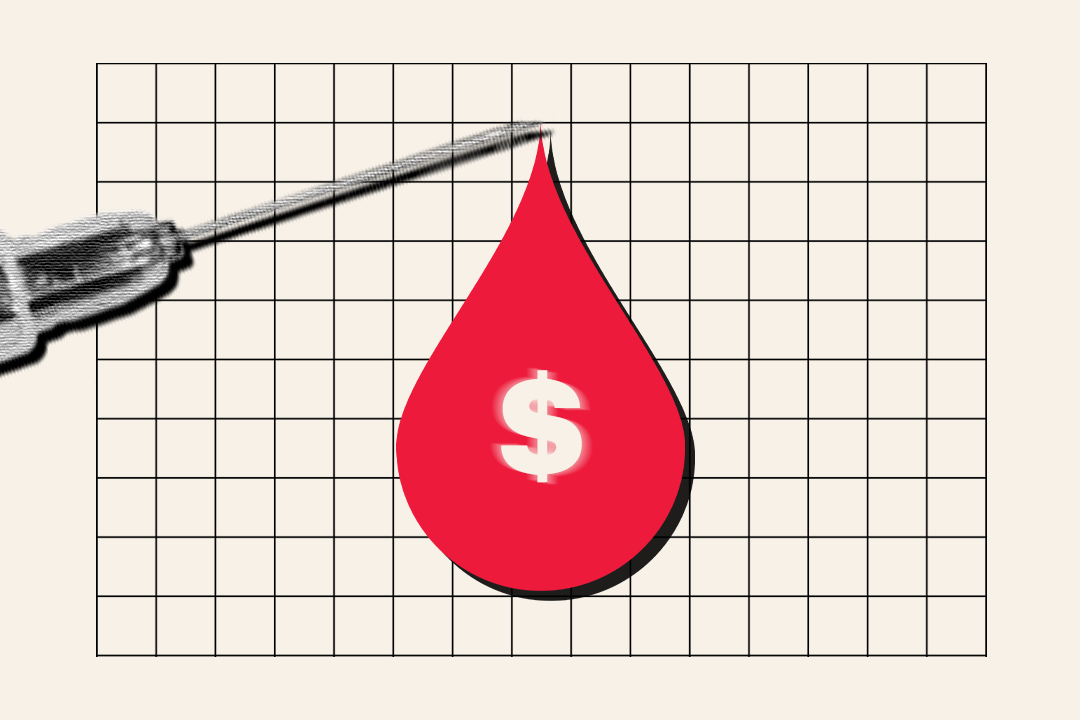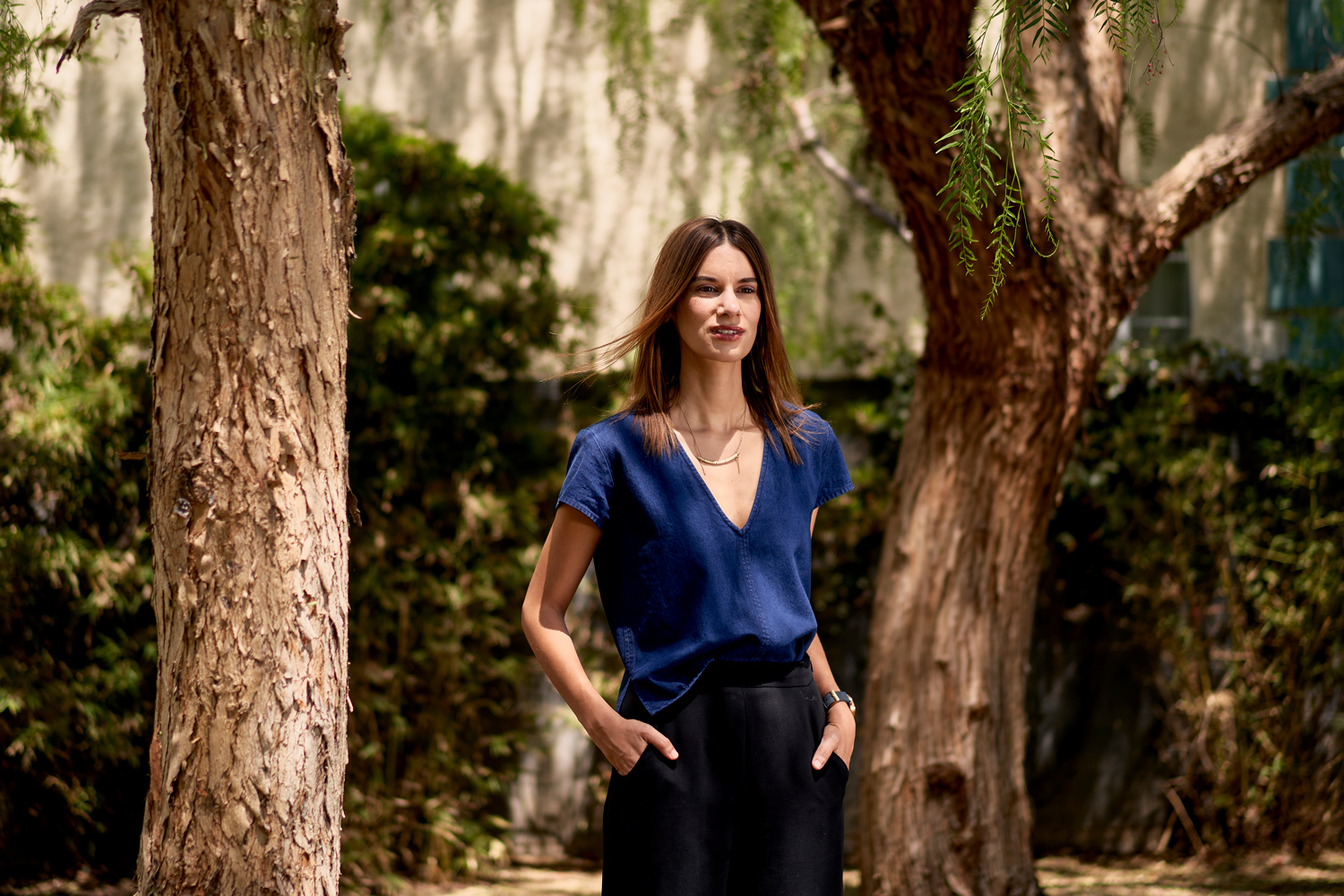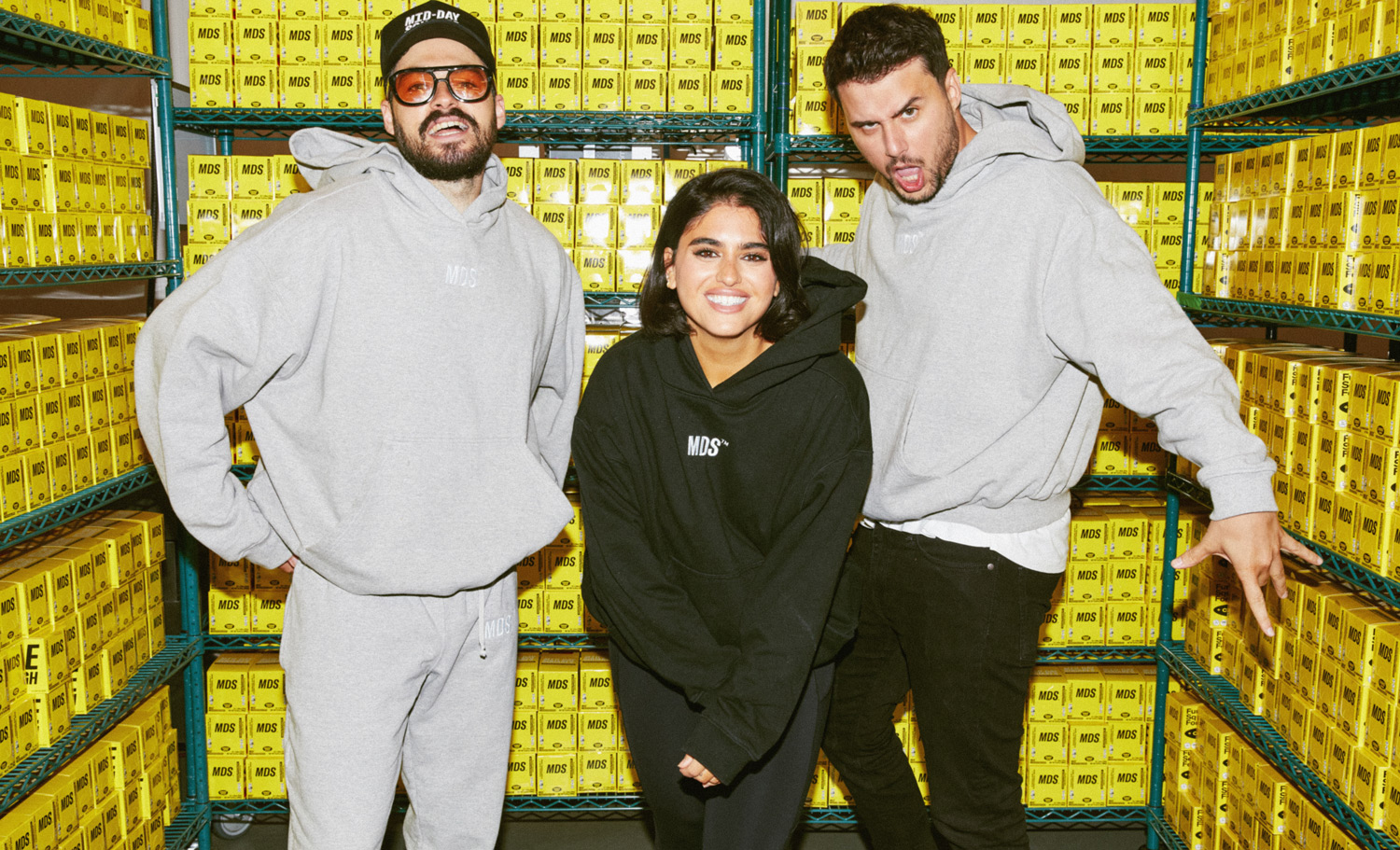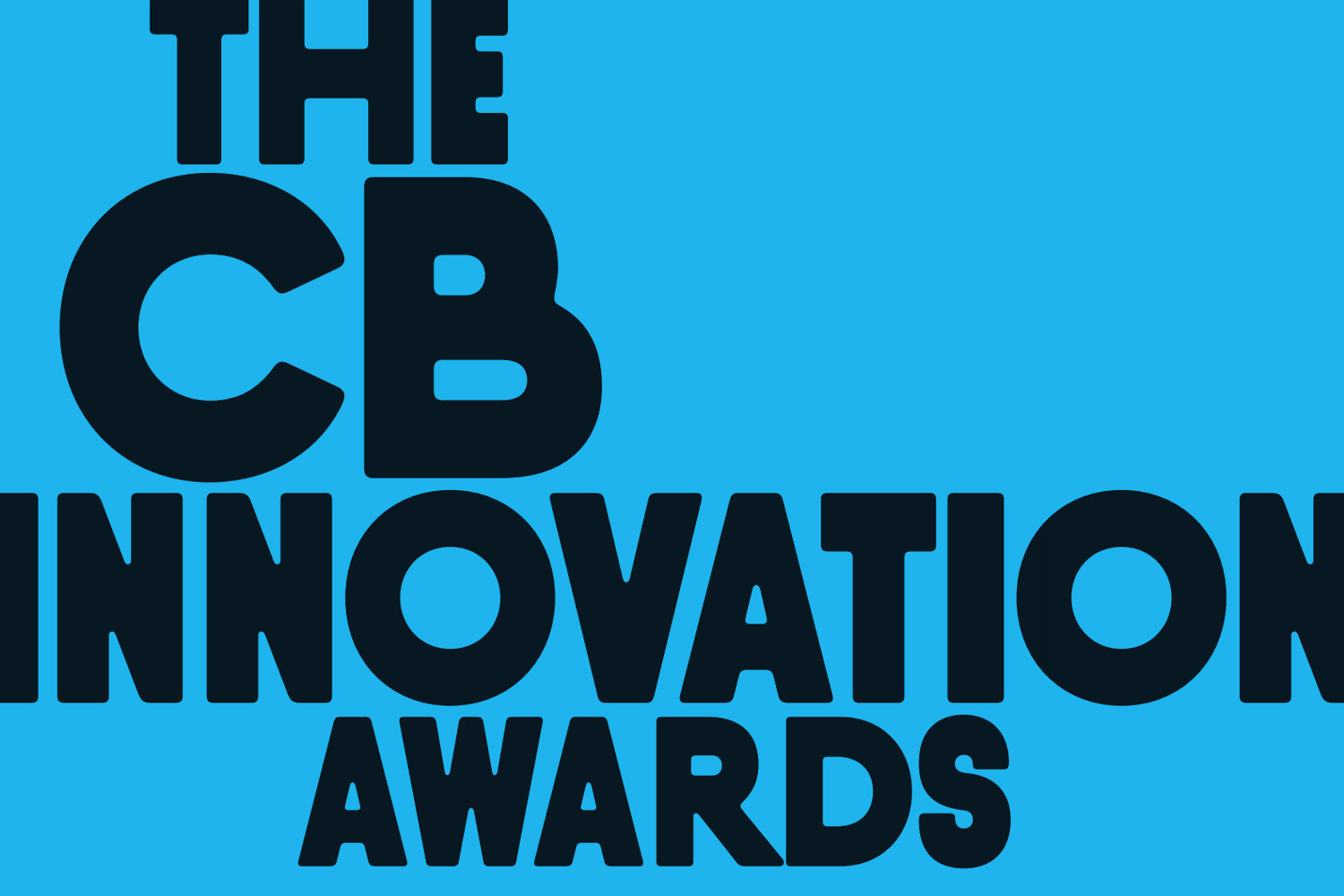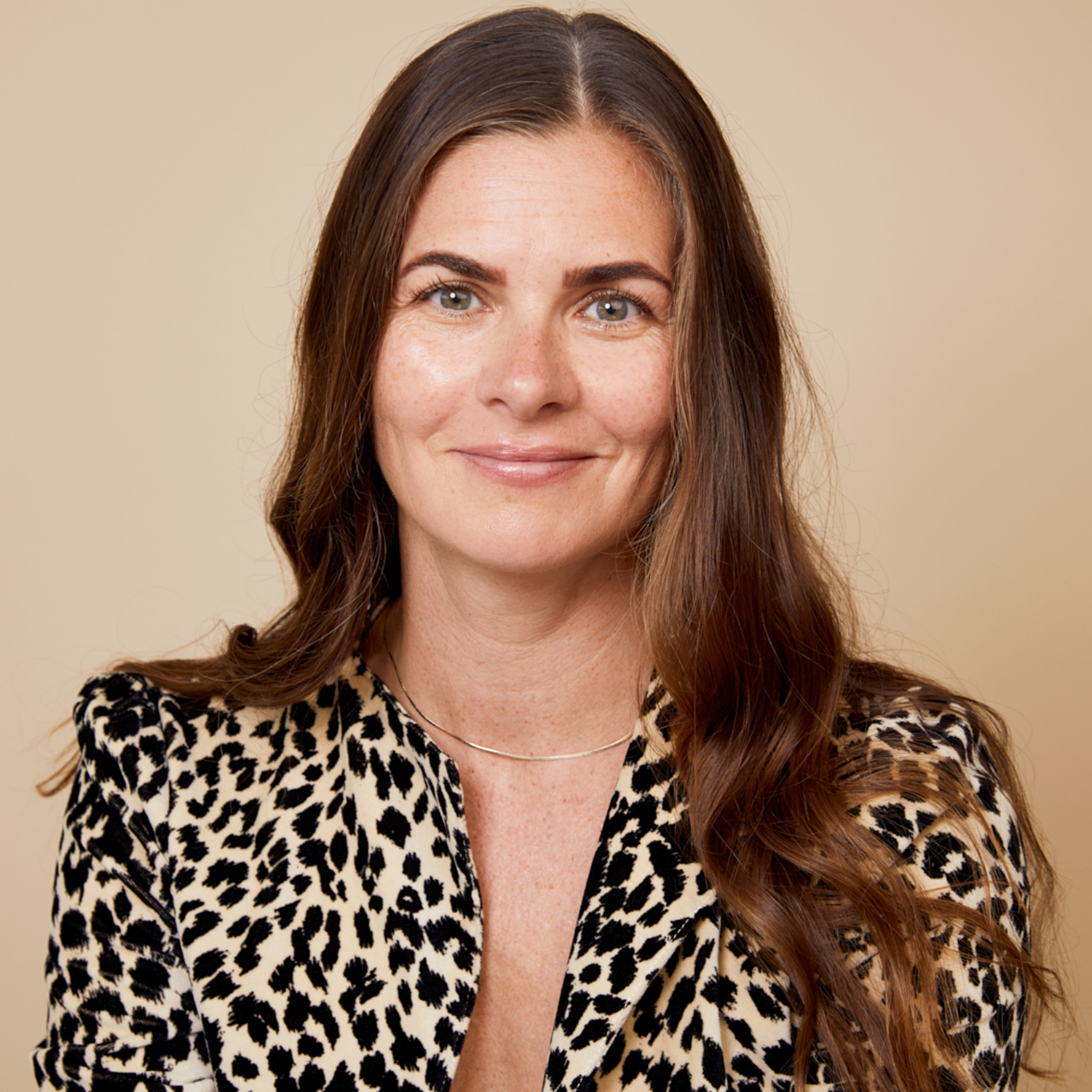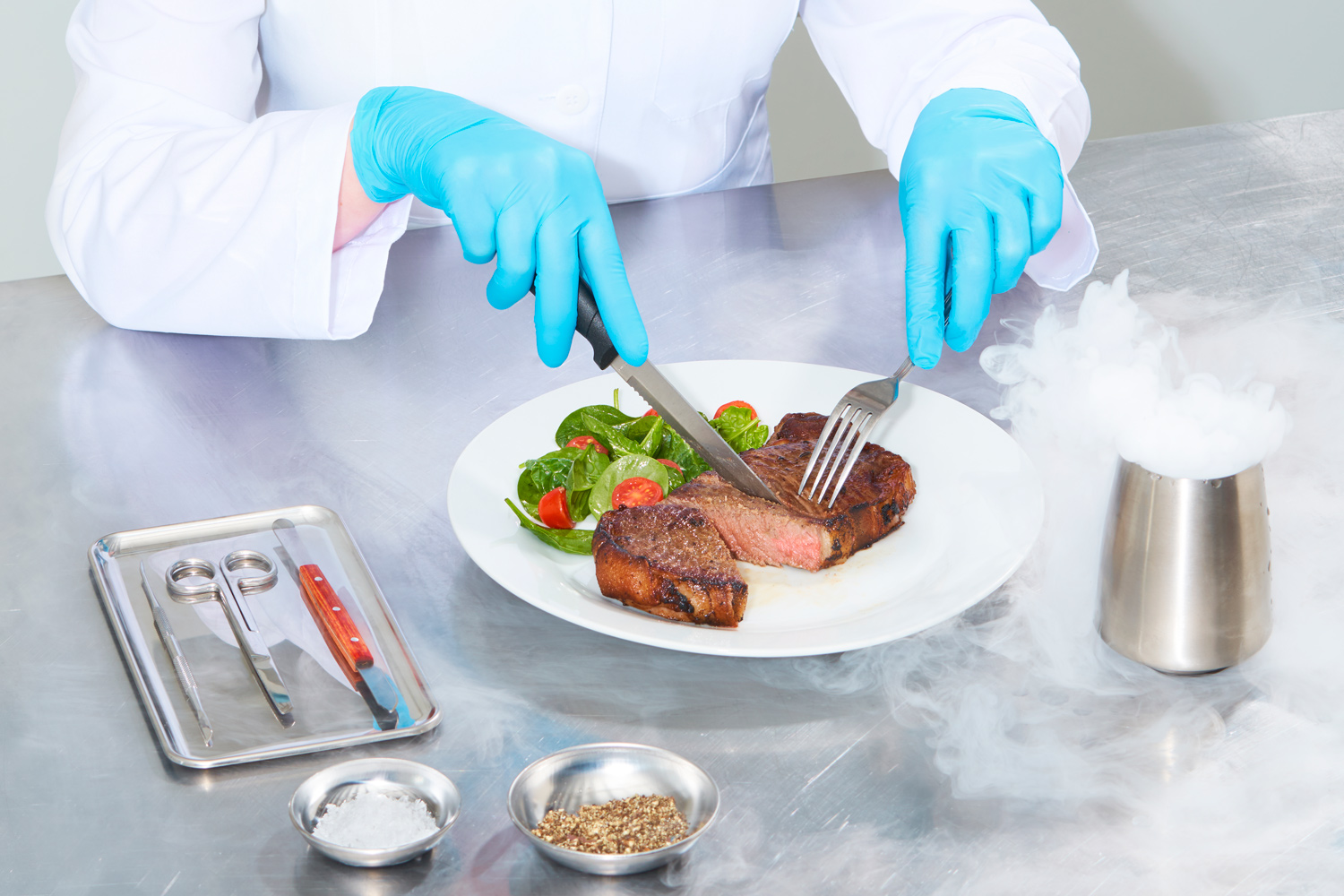
Back in the spring of 2014, Isha Datar, a 26-year-old molecular biologist, heard about an Irish accelerator looking for start-ups with big ideas in synthetic biology. Datar was working in Toronto as the executive director of New Harvest, a nonprofit that was formed to fund research and education in meat alternatives, but she was starting to feel a little restless. “I was kind of tired of being an advocate,” Datar says. “I wanted to see actual lab work being done.” Successful candidates for the accelerator, she learned, would get lab space and a cheque for 30 grand. Applications were due in four days.
Datar didn’t have a start-up. But she did have an email address for Ryan Pandya, a young biological and chemical engineer in Boston who was interested in the possibilities of in vitro dairy. And she’d just connected on LinkedIn with Perumal Gandhi, a biomedical engineer and student on Long Island who’d also floated the idea of making milk without a cow to her. They needed little convincing to go spend a summer in Ireland. Working in shared Google Docs from their respective cities, the trio gathered research, ran patent searches and investigated cell culture, protein structure and fermentation techniques. On April 22, they were told that their proposal had been accepted. Within a week, they’d incorporated their business, Muufri. (You know: moo-free.) By May, they’d assembled in Cork, three strangers from the internet getting to know each other over a beer. “We had complete trust in one another even though we’d never met,” Datar says.
Back then, lab-grown animal protein—meat and dairy products cultivated from cells instead of harvested from animals—was having a moment. The previous summer, at a splashy showcase in London, Dutch vascular physiologist Mark Post had unveiled the world’s first cell-cultured hamburger. Using techniques adapted from the field of tissue engineering, as well as €250,000 of Google co-founder Sergey Brin’s money, Post’s team plucked stem cells from a cow’s shoulder, nudged those cells to develop into thin fibres of muscle and formed 20,000 of the fibres into a patty, which was then browned before the audience in a pan with some butter and oil. (More fat, more salt, more pepper, the taste-testers agreed; failing that, more condiments.) “The burger felt like a stick in the sand,” Datar says. “It showed what was possible.”

Three months into the accelerator, the Muufri team discovered that it was also possible to coax a sort of milk powder from yeast spliced with the DNA sequence for casein protein. The trio had a prototype ready and a meeting on the books with Solina Chau, who co-founded the investment firm Horizon Ventures. They flew out to Hong Kong carrying a sample of their dairy-free milk—not quite 100 millilitres of the stuff so they wouldn’t have to check the plastic water bottle it was in—and emphasized to Chau and her team that it was a very early version. “The sample tasted horrible: It didn’t have milk’s sweetness, and you could definitely tell that it was powder mixed into water,” Datar says. “They were like, ‘We love the idea, but please don’t let anybody taste this ever again.’” That September, Horizon Ventures transferred US$2 million into Muufri’s bank account. (Datar soon left the company to focus on her duties with New Harvest, while Pandya and Gandhi changed Muufri’s name to Perfect Day, after the Lou Reed song that dairy scientists found spurred cows to produce more milk.)
Investors absolutely love the prospect of disrupting meat. In 2020, some US$350 million of private funding poured into the cultivated-meat industry, nearly matching all previous investments. By the start of 2022, that total had soared to almost US$3 billion. The cash has come from billionaires like Bill Gates and Richard Branson as well as behemoths like Nestlé and Maple Leaf Foods. When Datar started at New Harvest nine years ago, only a handful of scientists were working in the field. Now, more than 100 companies have emerged around the world.
The big numbers, however, don’t capture the big challenges with cell-cultured protein; in many ways, a proof of concept is the easiest part. “Mark Post’s burger gave people the sense that this food was just around the corner,” Datar says. But the industry hasn’t managed expectations about the journey to getting these products to consumers. For lab-grown meat to become more than a VC-bankrolled curiosity, it has to scale, and that presents difficulties—some a matter of science, some of equipment and some of marketing.
Still, we urgently need to find new ways to eat. Agriculture, deforestation and food production collectively account for more than a third of all human-caused greenhouse-gas emissions. A warming planet leads to a rise in extreme-weather events, which makes farming more difficult, which compels us to farm new land, which causes the planet to get even hotter. We need to break this cycle to avoid further catastrophe. Yes, we could all transition to a plant-based diet—but the fact is we haven’t yet, and we don’t seem inclined to: Almost half of Canadians eat meat on a daily basis. In transforming the way we eat, lab-grown meat has the potential to transform the way we live. It’s not a sure thing. But it could be, Datar says, “our once-in-a-lifetime opportunity to get a second chance at agriculture.”
In the beginning, there was “schmeat”: a term for meat produced synthetically from biological tissue and the Oxford Dictionary’s 2013 runner-up for word of the year. (The winner was “selfie.”) “Schmeat” gave way to “lab-grown meat,” which start-ups tend to side-eye for the vision it conjures of science experiments. “Clean meat,” another early contender, gets side-eyed instead by conventional meat producers, who don’t like the implication that their food is dirty. Currently, the industry preference is “cultivated meat” for its nod toward the bioreactors—or cultivators—in which the cells are grown.
It was Isha Datar who coined the phrase “cellular agriculture” (and its hipper shorthand, “cell ag”) when posting in a New Harvest Facebook thread in 2015. She liked that the term captured an important shift in location: “Cell” means “small room” in Latin, suggesting you could cultivate food in limited space rather than on an expansive farm. She also liked that the term didn’t distance itself entirely from conventional growing. “Telling the story of cell ag means we have to tell the story of animal agriculture and its problems first,” Datar says.
“The sample tasted horrible: It didn’t have milk’s sweetness, and you could definitely tell that it was powder mixed into water”
And those problems are considerable. Beyond the wildly dangerous conditions for workers in meat-packing facilities and the outbreaks of zoonotic diseases on factory farms, the livestock industry is a nightmare for the planet. Roughly 40 per cent of the earth’s land surface is used either to raise farmed animals or to grow the food they eat. When you add up the methane, carbon and nitrous oxide generated by meat and dairy production—all those belching cows, the mounds of fertilizer and manure, the machinery used along the way—the livestock industry is responsible for 14.5 per cent of the planet’s greenhouse-gas emissions.
“In my work, we often say there’s no silver bullet for climate change and biodiversity loss,” says Lenore Newman, director of the Food and Agriculture Institute at the University of the Fraser Valley. “But it’s a bit of a lie. Because there is, and it’s getting rid of meat.” If we moved the whole world over to a vegan diet, the UN says, we could get our greenhouse-gas emissions down to a third of their current level by 2050. By the end of the century, doing away with animal agriculture could provide half the emission reductions necessary to limit global warming to 2°C.
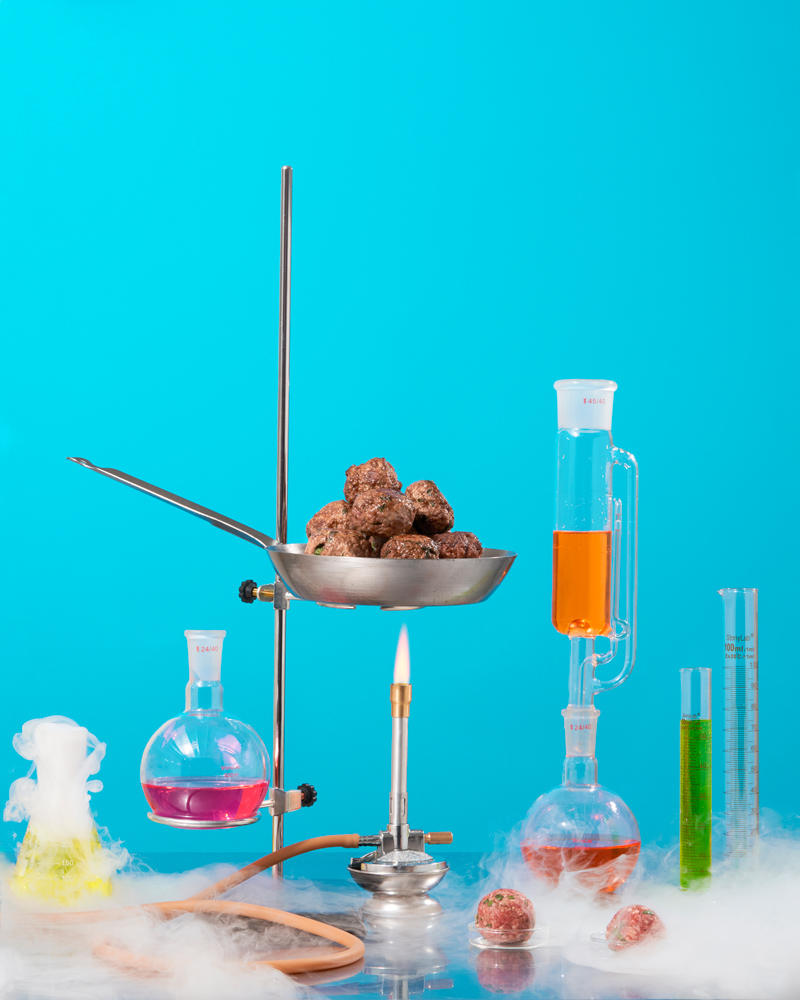
But not nearly enough of the world is willing to make do with plants. “There is a large cultural sunk-cost effect in meat,” Newman says. Meat is traditional; it’s primal. And its consumption is expected to double by 2050, with the greatest increases happening in low- and middle-income countries. In a 2021 UN opinion poll of 1.2 million people across 50 countries, two-thirds of respondents identified climate change as a global emergency. But among 18 potential responses to the crisis, shifting to a plant-based diet proved the least popular.
Datar believes that people want a more abundant future rather than a scarcer one—and for many people, veganism still seems like a diet of less. So why not train the force of our ingenuity on replicating cuts of meat instead? “Like, I know that cell ag is an over-engineered solution,” she says. “But I think there’s something human about that.”
Long before lab-grown steaks make their way to the supermarket, shelves will be filled with cultivated ice cream, yogourt and cream cheese. In fact, if you’ve consumed a single piece of cheese since 1990, you have very likely already sampled the fruits of cellular agriculture.
In order to get milk to curdle, cheesemakers need a set of enzymes called rennet, which they source from the stomach lining of slaughtered ruminants (most commonly calves). Cheese has been made this way for millennia—but in the 1970s, scientists thought they could do better in a lab. By the late ’80s, Pfizer was able to introduce chymosin, the enzyme that does most of the curdling, into E. coli and then use fermentation to manufacture artificial rennet. Ninety per cent of cheese is now made this way, and since there are no animal enzymes involved, it’s also halal and kosher.
This spin on brewing—using microflora to make animal-free dairy the same way yeast is used to make beer—is what allows Perfect Day (the start-up formerly known as Muufri) to mass-produce its milk protein. Here’s how. In 2009, an eight-year-old brown-and-white cow had her genome sequenced. These 22,000 genes offered clues that scientists said would explain “the essence of bovinity.” Among those clues, and relevant to Perfect Day’s interests: the genomic blueprint for whey protein. Scientists splice that blueprint, downloaded from a public database, into the DNA of super-industrious fungi so that the spores pass on the genetic information every time they reproduce. The fungi then head into a fermentation tank that contains everything necessary to keep them happy and growing: some sugars, a couple of minerals, a nice warm environment, a little oxygen. Once the fungi stop multiplying, the whey protein is separated, purified and dried into a powder.
Whey powder slides easily into cake mixes and gelato and protein shakes. Brave Robot ice cream, from Perfect Day’s consumer brand The Urgent Company, is available in flavours like buttery pecan and blueberry pie at more than 5,000 grocery stores across America; an animal-free cream cheese they created with General Mills recently landed on shelves. And for start-ups keen to make their own cowless dairy, Perfect Day launched a biotechnology-as-a-service business to help. It’s a model that has proven enticing to Leonardo DiCaprio (who serves as a company adviser) and former Disney CEO Bob Iger (who sits on Perfect Day’s board of directors). Regulatory approval for Perfect Day’s whey protein is still pending in Canada—the FDA granted it back in 2020—but our largest pension fund is already in on the action: CPP Investments co-led the last funding round, bringing total cash to US$750 million.
In 2018, when a San Francisco start-up called New Age Meats invited people to sample the world’s first cultivated sausage, guests did so under the watchful eye of a blush-pink pig named Jessie. As the founders passed around pan-fried links of Jessie’s fat and muscle, a photo of the happy hog, very much alive and mucking about on a farm in Marin County, Calif., flashed on a TV screen. In cellular agriculture, her presence implied, it’s totally fine to name the animals.
In order to make a piece of cell-cultured meat, you need some cells. At Tufts University, which recently received a US$10 million grant from the USDA to build a cell-ag institute, students can drive an hour west to the school of veterinary medicine, where there’s a working cattle herd. There, they snag a jelly-bean-size biopsy from the semitendinosus muscle in the cow’s hamstring and bring it back to the lab. Meanwhile, to make its nigiri, California cultivated-fish start-up Wildtype uses cells taken from silvery young coho Pacific salmon. Singapore’s Eat Just, which in 2020 became the first company to legally sell cultured meat, simply plucks a feather from a chicken.
If you can’t get to a farm, the internet will provide. The biological-resource centre American Type Culture Collection, for example, has a cell catalogue listing upward of 150 animal species, including rabbit and fowl. Traditionally, these cells have been used to study genes and cancers in order to develop vaccines and drugs, but they can also be put toward cellular agriculture. Cameron Semper, a research scientist in molecular biology at the University of Calgary, says acquiring mammalian cells is a breeze. “There are so many suppliers, it’s kind of like ordering something off Amazon,” he explains. Finding fish cells can be trickier. “The fish we eat aren’t highly relevant for studying human disease,” he says. But once researchers get their hands on the cells, they can treat them like sourdough starter, pinching off a little bit to begin the next batch.
“Telling the story of cell ag means we have to tell the story of animal agriculture and its problems first”
They then feed cells a broth dense with nutrients, vitamins, sugars, amino acids and small, critically important signalling proteins called growth factors, which tell the cells to divide or differentiate. As the cells multiply, they require more food and more oxygen; they also require a bioreactor that grows in size along with them like a set of Russian dolls.
The cultivated meat in these bioreactors comes out soft—more ground beef than marbled tenderloin. For some start-ups, that’s not a concern. Singapore-based Shiok Meats aims to grow minced shrimp for dumplings, soups and noodle dishes. “When you shell and devein a shrimp, you take out its organs, digestive system and heart, so what you have left is 100 per cent muscle,” says Sandhya Sriram, Shiok Meats’ CEO. “I wouldn’t say shrimp is simple, but it’s definitely less complex than a piece of beef.”
That’s because to make three-dimension cuts like steak or rib-eye, some sort of structural support, known as a “scaffold,” must be used. The scaffold provides the surface onto which cells attach and grow, and it guides their development into a recognizable shape. It can be made from all manner of materials, though there’s a preference in the field for a plant-based approach; at New Harvest, researchers are exploring options made from seaweed, spinach and grass. The scaffold might be reusable, dissolvable or entirely edible. But its presence adds complexity to the process—another reason cell-cultured milk is much further ahead than any piece of cell-cultured cow.
As the researchers and entrepreneurs working in this field mention again and again (and again), cellular agriculture will need to become far more efficient and far less expensive if it’s going to put a dent in the meat market, which is expected to reach US$1.4 trillion in the next four years. Prices have come down dramatically since Mark Post’s €250,000 burger: Currently, it costs roughly 50 bucks US to produce a pound of cultivated meat. But that’s still nowhere close to competing with a grocery store, where prices for chicken and meat are kept at rock bottom thanks to the $683 billion in government subsidies that industrial farmers receive worldwide.
Right now, whether a company is making a whole mess of sausages or a single steak, the bulk of production costs come from the growth media—that nutrient-rich broth that feeds cells. And more than 90 per cent of media costs come from growth factors, those bossy proteins that tell cells to grow or divide. A 2020 industry survey of cell-media suppliers put the price of growth factors as high as US$400,000 per gram. Jalene Anderson-Baron, co-founder of the Edmonton-based cell-ag start-up Future Fields, says price is one of the biggest obstacles to overcome. “Growth factors are primarily used for biomedical research, so there’s never been a need for this type of volume or a demand for it to be at a lower price point,” she says.
In biomedical research, the go-to growth-media additive is fetal-bovine serum, or FBS, which, as the name says, comes from the blood of a fetal calf taken from a pregnant cow destined for slaughter. FBS is hugely versatile, working with pretty much all cells: human, animal, fish, even insect. But there isn’t anywhere near enough of it to feed a hungry planet, and there tends to be a lot of variability from batch to batch—not ideal for a product destined for the food chain.
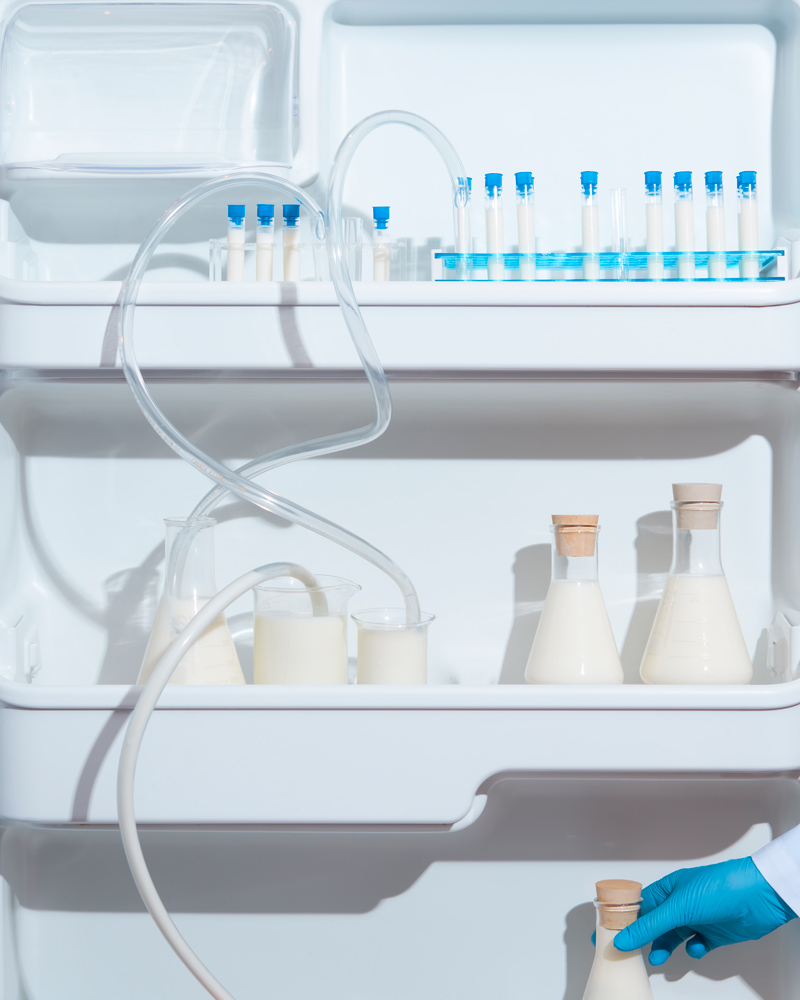
Then there are the optics: Using slaughtered calf fetuses to make food feels somewhat antithetical to the whole crueltyfree deal. Still, the majority of the muscle cells in Mark Post’s 2013 hamburger were grown with FBS. After Eat Just’s cultivated chicken nugget was approved in Singapore, the company confirmed that they use FBS in the production process. “FBS is like the spinach in the teeth of the field,” says Andrew Stout, a Ph.D. candidate at Tufts University who worked in Post’s lab. “So much relevant research happens with it, but then you have to say ‘Ultimately, I’d like to do this in a serum-free environment.’”
And growth media isn’t the only hurdle. Scientists simply don’t have the physical equipment needed to produce cultivated meat at a commodity scale. A sobering statistic: If every bioreactor in current use by the pharmaceutical industry were put toward manufacturing cell-cultured meat for a full year, it would only yield enough food to cover the meat Americans eat in a single day. Eat Just has said it might need 100,000-litre bioreactors—vessels that are 100 times bigger than the one the company uses now—to produce sufficient protein to stock grocery stores and fast-food chains. A bioreactor that size for animal cells doesn’t actually exist.
Even if it did, researchers aren’t sure how exactly cells would behave when asked to divide so many times—unbridled growth is going to produce a whole lot of waste. “Cells just can’t handle that amount of toxic poop,” Stout says. It might necessitate some genetic tinkering to make the cells hardier or to teach them, for example, how to act more like our livers and convert lactic acid into nutrients. If genetic tinkering is going to happen, scientists could also amp up the nutritional content of cultivated meat. Stout’s research looks at engineering beef cells to generate beta carotene (a valuable source of vitamin A). But that may be an uphill marketing battle: Consumers around the world tend to really dislike the notion of eating genetically modified foods.
And for cellular agriculture to make a difference, people will need to be persuaded to eat this stuff. There is some early research that suggests young people are more open to cellular agriculture than boomers and that people in Southeast Asia are keener to try cultivated meat than North American and European diners. Lenore Newman thinks framing cell-cultured products as cruelty-free will be crucial to getting people on board, since younger generations are especially concerned about animal welfare and environmental impact. Research out of Brock University in 2020 found that positioning cultivated meat as “natural”—no chemicals, no pesticides, no hormones—made for an effective message, as did the promise that it tasted very similar to traditional meat. But it’s difficult to conduct market research for a hypothetical product. “There’s no way to predict what the market will look like for this,” Newman says.
Were it up to Datar, cell ag’s proponents would make a far bigger fuss over the cutting-edge technology. “A lot of groups take a plant-like approach when describing their products—so, it’s healthier, it’s natural, it’s better,” she says. “I want to embrace that it’s different. And it’s cool that it’s different.” Brides on TikTok brag about their lab-grown diamonds precisely because those gems don’t involve the environmental damage and forced labour of traditional mining. Datar hopes that as the cell-ag industry gets closer to market, it might consider leaning into the lab.
Because cellular agriculture is so new and largely theoretical, it’s hard to pinpoint just how sustainable the industry might be. So far, the consensus is that this technology is pretty good for the planet. A 2011 assessment out of the universities of Oxford and Amsterdam reported that compared to conventional European meat production, cultivated meat lowers land use, water use and greenhouse-gas emissions by up to 96 per cent and demands up to 45 per cent less energy. A decade later, the Good Food Institute, which promotes alternatives to animal products, claimed that cultivated meat reduced the carbon footprint of chicken, pork and beef by a respective 17 per cent, 52 per cent and 92 per cent. “If we reforest a lot of the pasture land used for agriculture and return it to wilderness,” Newman says, “it helps obliterate the problem of climate change. That’s the prize at the end of this.”
Of course, the energy required to operate a series of 100,000-litre bioreactors is considerable, and to earn their sustainability cred, cell-ag start-ups will need to make use of renewable sources. If we stop bulldozing the Amazon for soy to feed cows but start bulldozing the Amazon for sugar to feed cells, we haven’t moved the needle on land and biodiversity loss. Researchers are investigating whether leftover crops or agricultural waste could be converted into a food source, and Newman is bullish on the potential of Canada’s sugar beets. “We grow so many starches and sugars here,” she says. “We’re in a great position to be a feedstock supplier for the global cell-ag industry.”
Cellular agriculture could be good for Canada in other ways too. In November, the Food and Agriculture Institute at the University of the Fraser Valley and Ontario Genomics released the country’s first report on cell ag’s economic possibilities. Among the rosy projections: up to 86,000 jobs created and as much as $7.5 billion worth of revenue in Canada by 2030. Growing the industry here will take its own kind of scaffolding, with investment in research, development, lab space, infrastructure, mentorship and regulation, as well as a national vision and strategy. It’s not a small amount of work. But that investment is happening in countries like Israel and the Netherlands. Singapore has committed tens of millions of dollars to cellular agriculture as part of its ambitious “30 by 30” plan, which aims to increase food sovereignty by producing 30 per cent of its food locally by 2030. “If we’re not investing here, we’re losing a huge opportunity to participate in this emerging global meat market,” says Bettina Hamelin, Ontario Genomics’ president and CEO. “In the next three to five years, the train may have left the station.”
There are already at least a dozen Canadian start-ups to invest in. Opalia, currently working out of Concordia University, makes whole milk out of mammary cells. CaroMeats creates functioning muscle and fat tissues by using cell sheets as building blocks, dispensing with the need for a scaffold for whole cuts of meat. And Edmonton’s Future Fields has discovered how to use cheap fruit flies to make those preposterously expensive growth factors, no fetal cow necessary. Anyone who’s ever left an overripe peach on the counter knows that fruit files breed easily and fast—they practically scale themselves.
“If we’re not investing here, we’re losing a huge opportunity to participate in this emerging global meat market”
As the industry grows, so might ambitions for the food that makes it to our dinner plates. There’s an understandable impulse to produce a marbled slab of cell-cultured steak, because it seems to represent what we want to eat. And there’s an equally understandable impulse to produce cultivated chicken breasts and ground beef, because they represent what we actually eat: The average Canadian consumes nearly 34 kilograms of white chicken meat and nearly 18 kilograms of beef—the majority of it ground—every year. But what if we didn’t limit ourselves to alternatives like I Can’t Believe It’s Not Bovine? What if we harnessed cell ag’s potential to produce cuts of meat from any kind of animal, not just the ones we happen to have domesticated?
Zebras are notoriously bad-tempered buggers, but they might just be delicious. Perhaps peacock would add more flavour to a coq au vin. Already, an Australian company called Vow is building a cell bank for animals that have been overlooked as food sources, including alpaca and kangaroo. Last September, American “de-extinction” company Colossal raised $15 million to splice the genes of an elephant with DNA recovered from a frozen mammoth—an enterprising food start-up could work with them to make woolly mammoth the new cornerstone of a paleo diet.
Plenty of people in the industry insist that bringing customers over to cultivated meat will come down to three factors: Make it easy to find and easy to afford, and make it easy to forget that it’s not actually chicken, and diners might make the switch. Datar is willing to give us even more credit than that. “I think new companies could let the technology determine the product instead of the other way around,” she says. “I think people could be drawn to weird and novel foods.” Science might not be able to build a better, greener burger. But lab-grown zebra ribs slow-cooked at a summer barbecue still sounds like an appetizing future.

